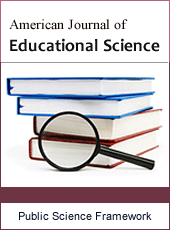American Journal of Educational Science
Articles Information
American Journal of Educational Science, Vol.1, No.4, Sep. 2015, Pub. Date: Jul. 20, 2015
The Availability and Suitability of Outdoor Play Environment for the Physically Challenged Children in Kisumu City ECD Centres
Pages: 165-170 Views: 4751 Downloads: 1810
[01]
Mary E. Kerich, Department of Curriculum, Instruction and Educational Media, Moi University, Eldoret, Kenya.
Outdoor play for physically disabled children has been regarded as not only a crucial part of their developmental stage but also as important for their holistic development. In Kenya, there has been progress in mainstreaming disabled children into the general system for education and care. However, very little progress has been made to extend this practice into the provision of play and recreation facilities for these children with special needs. This study thus set to investigate the status of play environments in Early Childhood Development (ECD) centers in relation to the needs of disabled children. The main concern of the study was to establish the suitability of outdoor play environment for the physically challenged children. The suitability was gauged using four major parameters namely; provision of appropriate facilities, inclusion of the disabled in outdoor play activities and availability of supporting adults. The study was done in Kisumu city in Kenya. Kisumu city has 512 ECD centers with the majority of these being public and run by Parents Teachers Associations (PTAs). The study population comprised of all the teaching staff (head-teachers and ECD teachers) in all the ECD centers in the city. Purposive sampling was used to select 20 urban ECD centers in Kisumu city that constituted the sample. Data was collected from the selected respondents by use of interviews, an event observation schedule and observation checklist. The results showed that the facilities for outdoor play for physically disabled children in the ECD centres were inadequate. Additionally, there was a limitation in use of some of the available resources due to the unsuitability of the environment in terms of space and safety. On the bright side, all the centres had supporting adults employed specifically to support the disabled children in outdoor play activities. The study recommends that the head teachers of the ECD centres in conjunction with the Ministry of Education should plan for increase of outdoor play space and equipment for physically challenged children to enable them engage fully in outdoor play. Physically challenged children’s development in outdoor play should also be enhanced by varying equipment and materials to encourage gross and fine motor development.
Physically Challenged Children, Outdoor Play, Ecd Centres, Holistic Development
[01]
Bines, H., & Lei, P. (2011). Disability and education: The longest road to inclusion. International Journal of Educational Development, 31(5), 419-424.
[02]
Bronfenbrenner, U. (2000). Ecological theory. Encyclopedia of psychology, 3, 129-133.
[03]
Creswell, J. W. (2013). Research design: A qualitative, quantitative, and mixed method approaches. Sage publications.
[04]
Farrell, P. (2001). Current issues in special needs: Special education in the last twenty years: have things really got better?. British Journal of Special Education, 28(1), 3-9.
[05]
Frost, J. L., Wortham, S. C., & Reifel, R. S. (2008). Play and child development. Upper Saddle River, NJ: Pearson/Merrill Prentice Hall.
[06]
Lewis, A. (2002). Children's understanding of disability. Routledge.
[07]
Linard, C., Gilbert, M., Snow, R. W., Noor, A. M., & Tatem, A. J. (2012). Population distribution, settlement patterns and accessibility across Africa in 2010. PloS one, 7(2), e31743.
[08]
Miller, E., & Almon, J. (2009). Crisis in the Kindergarten: Why Children Need to Play in School. Alliance for Childhood (NJ3a).
[09]
Raudsepp, L., & Pall, P. (2006). The relationship between fundamental motor skills and outside-school physical activity of elementary school children. Pediatric Exercise Science, 18(4), 426.
[10]
UNICEF (Ed.). (2005). The state of the world's children 2006: excluded and invisible. Unicef.
[11]
Wohlwend, K. E. (2011). Playing their way into literacies: Reading, writing, and belonging in the early childhood classroom. Teachers College Press.
[12]
Wood, E., & Attfield, J. (2005). Play, learning and the early childhood curriculum. Sage.

ISSN Print: 2381-7127
ISSN Online: 2381-7135
Current Issue:
Vol. 6, Issue 2, June Submit a Manuscript Join Editorial Board Join Reviewer Team
ISSN Online: 2381-7135
Current Issue:
Vol. 6, Issue 2, June Submit a Manuscript Join Editorial Board Join Reviewer Team
| About This Journal |
| All Issues |
| Open Access |
| Indexing |
| Payment Information |
| Author Guidelines |
| Review Process |
| Publication Ethics |
| Editorial Board |
| Peer Reviewers |


